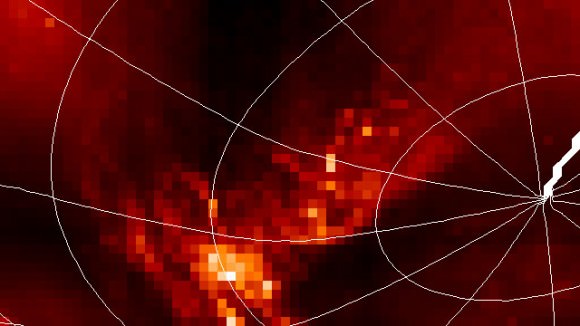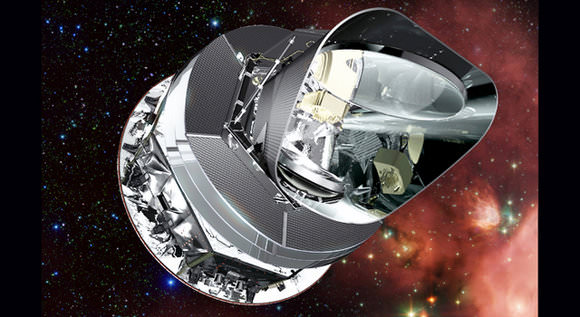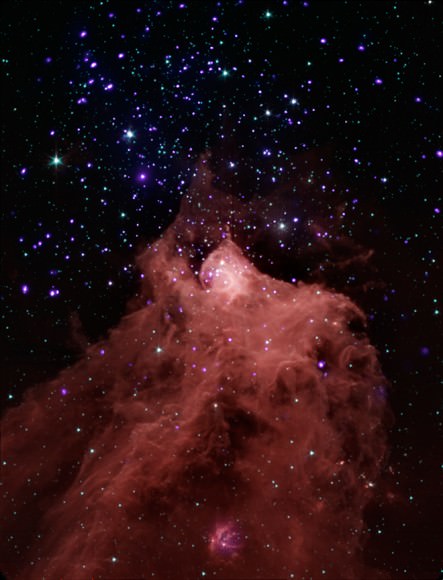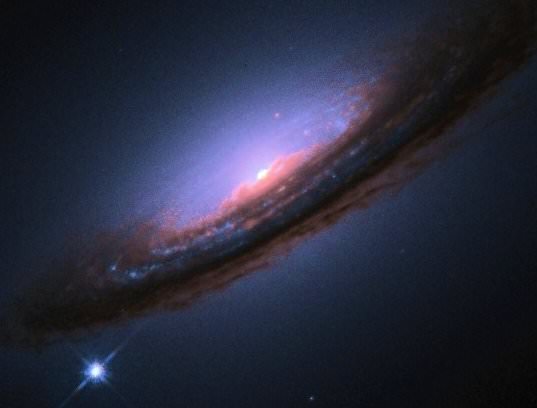Researchers Say Sun Cycle Alters Earth's Climate

If the energy from the sun varies by only 0.1 percent during the 11-year solar cycle, could such a small variation drive major changes in weather patterns on Earth? Yes, say researchers from the National Center for Atmospheric Research (NCAR) who used more than a century of weather observations and three powerful computer models in their study. They found subtle connections between solar cycle, the stratosphere, and the tropical Pacific Ocean that work in sync to generate periodic weather patterns that affect much of the globe. Scientists say this will help in predicting the intensity of certain climate phenomena, such as the Indian monsoon and tropical Pacific rainfall, years in advance.
(...)
Read the rest of Researchers Say Sun Cycle Alters Earth's Climate (685 words)
Fog on Titan? Help Review Mike Brown's Paper

Titan is the only place in the solar system other than the earth that appears to have large quantities of liquid sitting on the surface. Granted, conditions on Titan are quite different than on Earth. For one thing, it's a lot colder on Titan and the liquids there are various types of hydrocarbons. "Methane is to Titan what water is to the earth," says astronomer Mike Brown (yes, that guy, of Pluto, Eris and Makemake fame.) But now Brown and his colleagues have discovered another similarity. Titan has fog. "All of those bright sparkly reddish white patches (shown in the image here) are fog banks hanging out at the surface in Titan's late southern summer," Brown wrote in his blog.
Wow.
(...)
Read the rest of Fog on Titan? Help Review Mike Brown's Paper (459 words)
New Images Reveal Details of the Trifid Nebula
You'll have no trouble at all enjoying these stunning new images of the Trifid Nebula. This massive star factory is so named for the dark dust bands that trisect its glowing heart, and is a rare combination of three nebula types: reflection, emission and dark nebulae. With these new images from ESO’s La Silla Observatory in northern Chile, astronomers are learning more about the early stages of stellar life, from gestation to first light.
(...)
Read the rest of New Images Reveal Details of the Trifid Nebula (416 words)
Mars Kicking Spirit When She's Down

The Spirit rover has been stuck in loose soil on Mars for several months now, and just as the rover team is preparing to execute maneuvers to attempt to free Spirit, a dust storm hits. Is Mars an unforgiving planet or what? The amount of electricity generated by the solar panels on Spirit has been declining for the past several Martian days, or sols, because of the storm, and Spirit's daily activities have been trimmed. Those watching over the rover are keeping an eye on weather reports from observations by NASA's Mars Reconnaissance Orbiter. While the rover team at JPL are keeping their "spirits" up, a recent image from the rover indicates Spirit herself might be getting frustrated with her string of bad luck:
(...)
Read the rest of Mars Kicking Spirit When She's Down (309 words)
Astro Art of the Week: Music and the Heavens
This week's featured Astro Art was created by Universe Today reader Bhavya Mittal. Bhavya calls it "Music combines the soul and the heavens," and explains the image: "On the bottom left is the most dangerous black hole identified till now. On the top right is the Crab Nebula, and below it, as you can see, is our dear Solar System. This image shows that when you are totally engrossed in music,you really get the feel of the Universe. At least I have felt it!"
(...)
Read the rest of Astro Art of the Week: Music and the Heavens (74 words)
Help Solve the Mystery of Epsilon Aurigae with Citizen Sky
We've written about Epsilon Aurigae before, but this mysterious star is just now beginning to dim, so we wanted to remind everyone that they can be involved in real science and help solve a mystery! The variable star Epsilon Aurigae is now beginning its puzzling transformation that happens every 27 years. "That means the last time Epsilon Aurigae had an eclipse we were all rockin’ big hair and sporting shoulder pads in all of our clothes," said Rebecca Turner, coordinator for a special project for the IYA organized by the American Association of Variable Star Observers (AAVSO). Astronomers can't figure out why this mysterious star dims on a regular basis, so to help solve the mystery they are calling for assistance from thousands of citizen scientists.
That means you can help contribute to real astronomical research!
(...)
Read the rest of Help Solve the Mystery of Epsilon Aurigae with Citizen Sky (679 words)
Space Shuttle Launch Scrubbed for Wednesday Morning
NASA officially scrubbed the second attempt for launching the STS-128 mission. "The last half an hour or so, a problem cropped up with a fill-and-drain valve in the bottom part of the shuttle, the aft part of the shuttle, related to the liquid hydrogen," said NASA TV launch commentator Allard Beutel. "This particular valve … gave indications it did not close when it was commanded to."
No word yet on what might be needed to replace the valve or restore it to normal operation. NASA is currently targeting the next launch attempt for Friday at 4:22 GMT (12:22 am ET) pending a review analysis on the valve issue.
NASA only has until August 30 to launch Discovery or the flight will be delayed to mid October because of upcoming Japanese and Russian space station missions and a conflict with the Air Force Eastern Range. We'll keep you posted.
NASA Science News for August 21, 2009
The agency best known for exploring the vast reaches of space has been exploring some of the vast beaches of Earth – and the results may help protect them.
FULL STORY at
http://science.nasa.gov/headlines/y2009/21aug_mobilebay.htm?list1035898
NASA Science News for August 19, 2009
Astronomers are celebrating 10 years of discovery by NASA's Chandra X-ray Observatory. Today's story highlights some of Chandra's most surprising, violent and beautiful images of the high-energy Universe.
FULL STORY at
http://science.nasa.gov/headlines/y2009/19aug_chandra10.htm?list1035898
Planck Starts Collecting Light Left Over From Big Bang
As of August 13, 2009, the Planck mission is officially in business. It is now seeing light billions of years old, left over from the Big Bang. From its location in the L2 point, the spacecraft started collecting science data as part of the "First Light Survey" which is intended to check out all the systems. If all goes as planned, these observations will be the first of 15 or more months of data gathered from two full-sky scans.
(...)
Read the rest of Planck Starts Collecting Light Left Over From Big Bang (182 words)
NASA Science News for August 14, 2009
A powerful cosmic ray detector to be installed on the International Space Station will search for antimatter galaxies and other exotic phenomena in the Universe.
FULL STORY at
http://science.nasa.gov/headlines/y2009/14aug_ams.htm?list1035898
NASA Doesn't Receive Enough Money for Mandated Asteroid Search

In 2005, the US Congress mandated that NASA discover 90 percent of all near-Earth objects 140 meters in diameter or greater by 2020. But they forgot one minor detail: Congress or the administration did not request or appropriate any new funds to meet this objective, and with NASA's existing budget, there is no way NASA can meet the mandated goal.
Does anyone else see a pattern here?
(...)
Read the rest of NASA Doesn't Receive Enough Money for Mandated Asteroid Search (532 words)
Hunt for Supernovae With Galaxy Zoo

How would you like to find a supernova? I can't think of anyone who wouldn't be proud to say they have spotted an exploding star. And now, perhaps you can – and without all the work of setting up your telescope and staying up all night (well, that can be fun, too, but…). The great folks who brought you Galaxy Zoo have now partnered with the Palomar Transit Factory to offer the public a chance to hunt and click for supernovae from the comfort of your own computer. And yes, you can still classify galaxies at Galaxy Zoo, but now you can search for for the big guns out in space, too. Sound like fun?
(...)
Read the rest of Hunt for Supernovae With Galaxy Zoo (261 words)
Trigger-Happy Star Formation in Cepheus B
Combining data from the Chandra X-Ray Observatory and the Spitizer Space Telescope allowed astronomers to create this gorgeous new image of Cepheus B. Besides being incredible eye candy, the new image also provides fresh insight into how some stars are born. The research shows that radiation from massive stars may trigger the formation of many more stars than previously thought.
(...)
Read the rest of Trigger-Happy Star Formation in Cepheus B (487 words)
Variability in Type 1A Supernovae Has Implications for Studying
The discovery of dark energy, a mysterious force that is accelerating the expansion of the universe, was based on observations of type 1a supernovae, and these stellar explosions have long been used as "standard candles" for measuring the expansion. But not all type 1A supernovae are created equal. A new study reveals sources of variability in these supernovae, and to accurately probe the nature of dark energy and determine if it is constant or variable over time, scientists will have to find a way to measure cosmic distances with much greater precision than they have in the past.
(...)
Read the rest of Variability in Type 1A Supernovae Has Implications for Studying Dark Energy (904 words)






